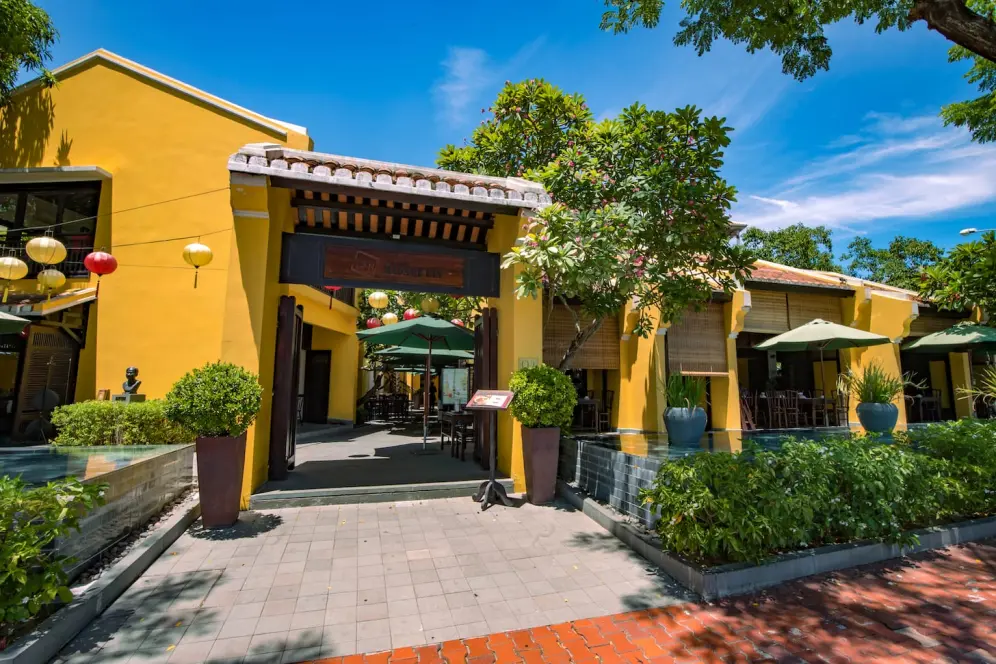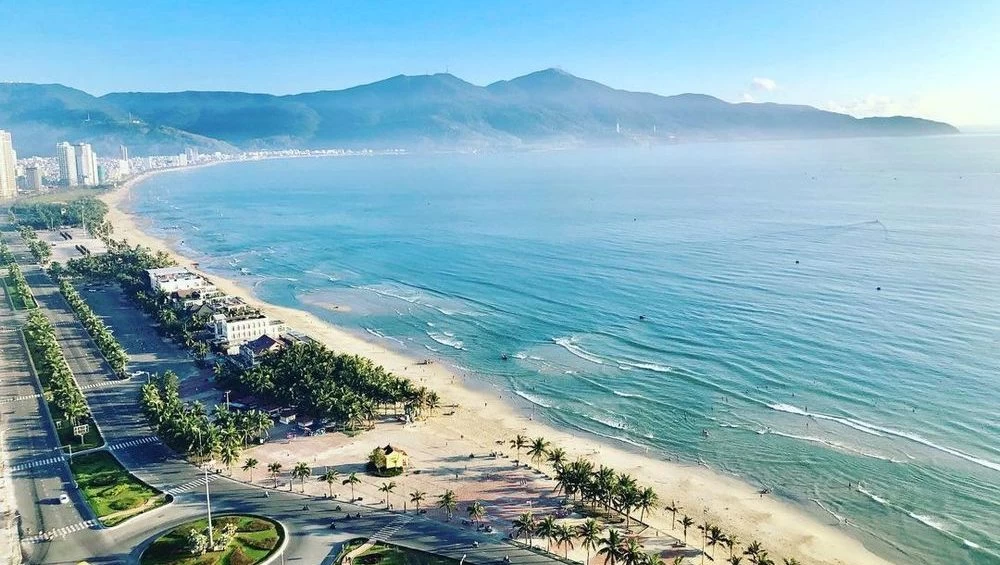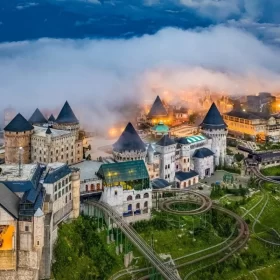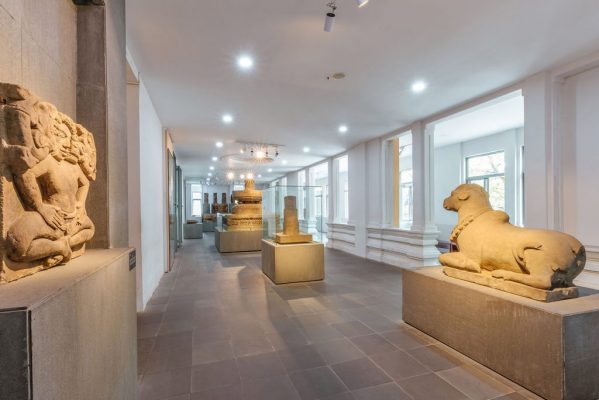
Cham Museum – a living cultural treasure
Discover the Cham Museum in Da Nang – Explore the unique cultural heritage of the Cham people at Da Nang’s Cham Museum. Learn about Cham history, exquisite artifacts, and their significance in Southeast Asian art. Plan your visit and immerse yourself in this enriching cultural experience. Ideal for tourists from everywhere seeking to delve into Vietnam’s rich cultural tapestry.
I. Introduction to the Cham Museum
1. Overview of the Cham Museum
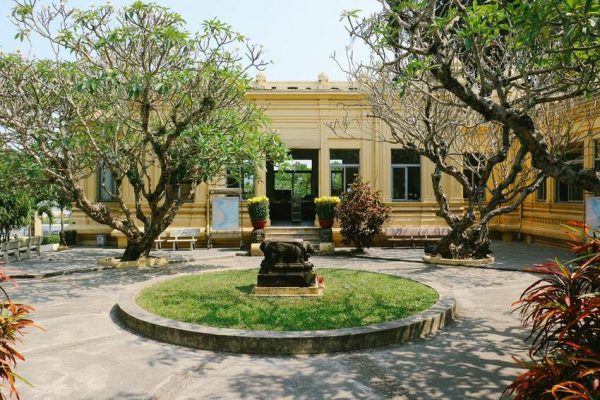
The museum bears little traces of French construction
The Cham Museum is a treasure trove of ancient artifacts and artworks that offer a fascinating glimpse into the rich cultural heritage of the Cham civilization. Established in 1915 by the French School for Far Eastern Studies, this museum is dedicated to preserving and showcasing the remnants of the Cham Kingdom, which flourished in Central Vietnam from the 2nd to the 17th centuries.
2. Location of the Cham Museum
Situated in the heart of Da Nang, the Cham Museum is conveniently located near the Han River and within walking distance from many of the city’s main attractions. This prime location makes it an easily accessible destination for both local and international tourists. The museum’s proximity to other notable landmarks, such as the Dragon Bridge and the Marble Mountains, allows visitors to include it as a key part of their cultural exploration of Da Nang.
3. What Makes the Cham Museum Attractive to Tourists?
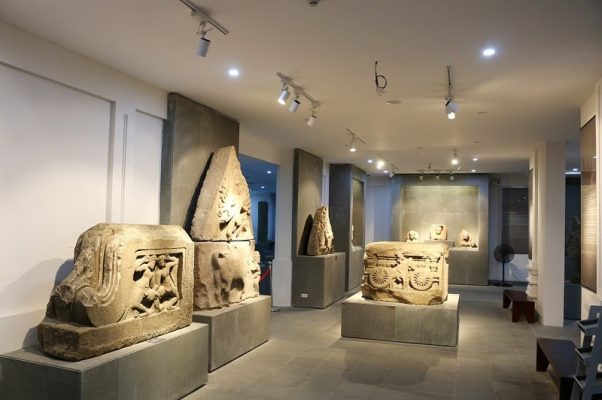
The museum is an attractive place for those who love history and culture
The Cham Museum is not just a repository of historical artifacts; it is a gateway to understanding the profound impact of the Cham culture on Vietnam’s history and its influence on Southeast Asia. International tourists are particularly drawn to the museum’s extensive collection of over 2,000 pieces of Cham sculpture, including exquisite stone carvings, terracotta sculptures, and religious icons. These artifacts offer a unique opportunity to witness the artistry and spiritual life of the Cham people.
Moreover, the museum’s well-curated exhibits are accompanied by informative descriptions in multiple languages, making them accessible to a global audience. The Cham Museum’s significance is further enhanced by its role in preserving a nearly forgotten civilization, offering a rare educational experience that appeals to history enthusiasts, art lovers, and curious travelers alike.
II. History and Origins of the Cham Museum
1. A Brief History of the Cham Museum
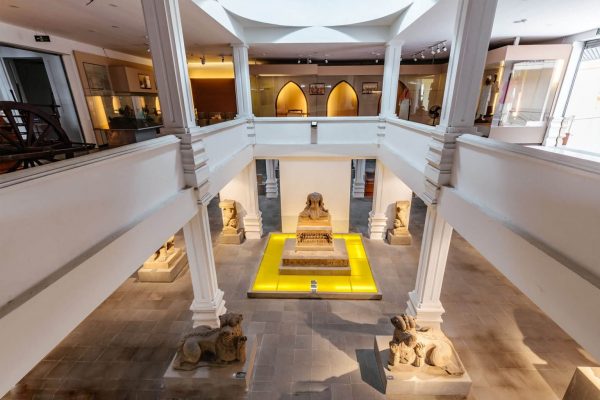
Cham Museum is the place that stores the largest number of Cham cultural artifacts
The Cham Museum, officially known as the Museum of Cham Sculpture, was established in 1915 during the French colonial period in Vietnam. It was initiated by the École française d’Extrême-Orient (EFEO) with the primary purpose of preserving and showcasing the rich cultural heritage of the Cham people. The museum is an architectural blend of French colonial and Cham elements, designed by French architects Delaval and Auclair.
2. Significant Historical Events
- Foundation and Early Years (1915–1936): The museum’s foundation stone was laid in 1915, and it officially opened its doors to the public in 1919. During these early years, the collection was primarily composed of sculptures and relics gathered from various Cham sites, such as My Son, Tra Kieu, and Dong Duong.
- Expansion and Renovations (1936–1946): In 1936, the museum underwent its first major expansion to accommodate the growing collection of artifacts. The new wing, completed in 1939, was designed to blend seamlessly with the original structure, maintaining the architectural integrity of the museum.
- Post-Colonial Period (1946–1975): After Vietnam gained independence from French colonial rule, the Cham Museum continued to operate and preserve Cham cultural artifacts despite the challenges posed by political and social upheavals. During the Vietnam War, the museum remained open, though it faced difficulties in maintaining its collections due to the conflict.
- Modern Era and Restoration (1975–Present): Following the end of the Vietnam War, the museum was placed under the management of the Vietnamese government. Efforts were made to restore and conserve the artifacts, many of which had suffered damage or neglect during the war years. In recent decades, the museum has seen further expansions and modernizations, including the addition of climate-controlled galleries and improved visitor facilities.
3. Cham Culture
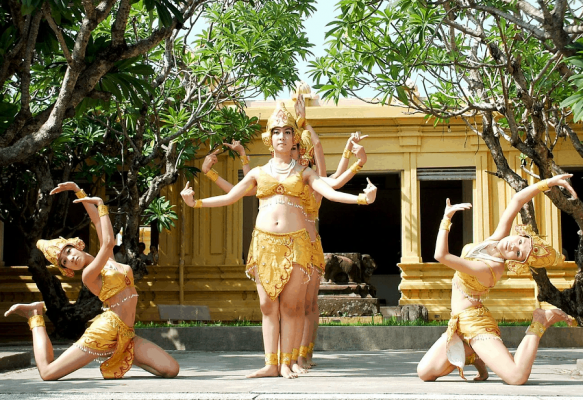
Cham culture plays an important role in Vietnamese history
The Cham people, also known as the Champa, were an indigenous people who inhabited the central and southern coasts of Vietnam from around the 2nd century AD until the 19th century. They were known for their sophisticated maritime trade networks, which extended to India, Persia, and beyond. The Cham civilization is particularly renowned for its advancements in architecture, sculpture, and the arts, heavily influenced by Hinduism and later Buddhism.
Cham culture played a crucial role in the history of Vietnam, contributing to the country’s diversity in terms of religion, art, and architecture. The Cham legacy is evident in the numerous temples, towers, and artifacts scattered throughout central Vietnam. The Cham Museum serves as a vital repository of this heritage, housing the world’s largest collection of Cham artifacts.
III. Highlights of the Cham Museum
1. The Main Exhibition Rooms and Precious Artifacts
a. The My Son Gallery
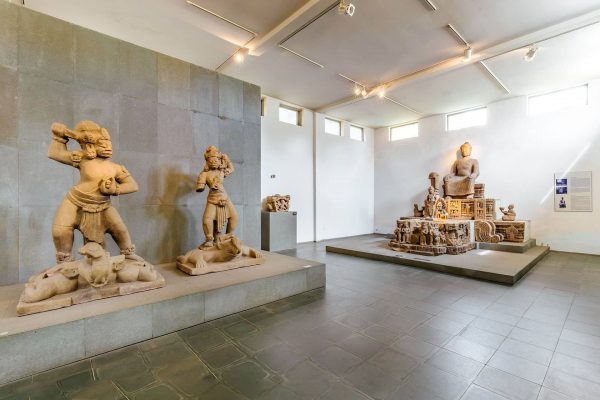
The My Son Gallery
The My Son Gallery houses artifacts such as the birth of Brahma and altars. Notably, the altar in the My Son Gallery is the only existing relic found today that reflects the religious life of Cham priests who followed Hinduism.
All the artifacts were excavated between 1903 and 1904 at My Son, the important religious center of Cham. Among these, the My Son E1 altar has been recognized as a national treasure. The artifacts in the My Son Gallery are exemplary works representing various artistic styles of the Cham, including architectural sculptures of towers, deities, and scenes of daily life.
Are you looking for: Da Nang tours
b. The Tra Kieu Gallery
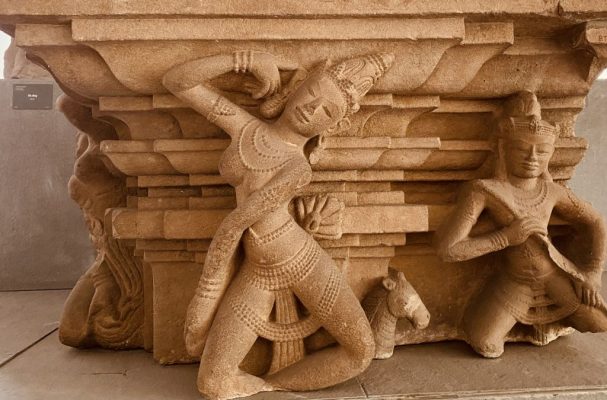
Treasure trove of Apsara dancer Tra Kieu
The Tra Kieu Gallery houses artifacts excavated from the Tra Kieu site, located in Duy Sơn Commune, Duy Xuyen District, Quang Nam Province, during the late 19th and early 20th centuries. The artifacts on display here include fragments of altars, Vinsu, Linga, and various other decorative reliefs.
Among these, the Bas-relief of Apsara dancer Tra Kieu is one of the nine national treasures preserved at the Da Nang Museum of Cham Sculpture since 2012. Most of the artifacts in this gallery are identified as belonging to the 10th–11th centuries and are stone sculptures from Cham culture, characterized by vibrant, soft, and diverse artistic expressions in terms of movements and costumes.
Do not miss: Da Nang to Hue – Unexpected Trip You’ll Love
c. The Dong Duong Gallery
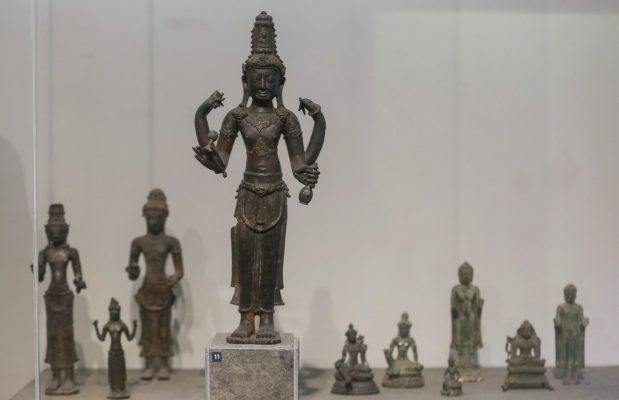
The Dong Duong Gallery
The Dong Duong Gallery houses statues of Bodhisattvas and the Dong Duong altar discovered in 1902 at Dong Duong, the Buddhist center of the Cham kingdom. The Dong Duong altar has been recognized by the state as one of the national treasures.
These artifacts date back to the late 9th century to the early 10th century and are Buddhist sculptures with the unique style of Cham art, heavily influenced by local elements. Additionally, these works also exhibit some influences from neighboring countries such as China, India, and other nearby nations.
Start your journey with: Da Nang to Hoi An in 4 Days
2. Thematic Exhibition Area at the Cham Museum
a. Sa Huynh, Cham Pottery
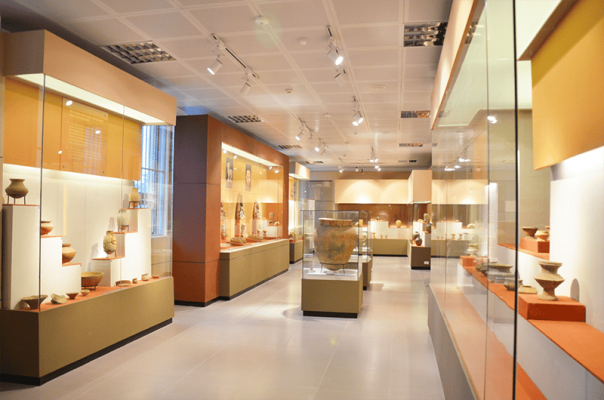
The Sa Huynh- Cham Pottery area
The Sa Huynh- Cham Pottery area showcases the art of Sa Huynh and Cham pottery, with most of the artifacts unearthed in 1909. Pottery is a significant element of Sa Huynh culture. Researchers believe that Sa Huynh pottery artifacts have a connection with Cham culture in the central region from the 3rd century onwards.
Cham pottery artifacts inherit the material, firing techniques, colors, and firing levels of Sa Huynh pottery. Cham pottery is not only a common building material but also a unique artistic symbol in Cham architecture. Besides being used for roofing and flooring, Cham pottery was also used to decorate various architectural details, contributing to the exquisite and impressive beauty of the structures.
You will be like: Discover Central Vietnam Tour in 6 Days
b. Cham Culture in Ninh Thuan
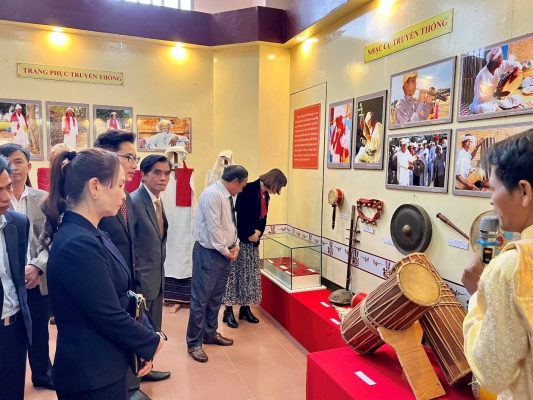
Thematic exhibition-Cham Ninh Thuan Culture
This area houses significant artifacts of Cham culture, such as musical instruments, costumes, festivals, and daily life. Additionally, it displays numerous sculptures and paintings about Cham culture.
c. Photo Exhibition: 100 Years of Cham Sculpture Museum
The photo exhibition area opened to visitors in 2019 to commemorate the 100th anniversary of the museum’s first exhibition. It displays over 250 photos depicting notable activities throughout the 100-year history of the Da Nang Cham Museum, organized by theme and chronological order as follows:
- Artifacts were brought back by the French and placed in Tourane Park (Da Nang) before the museum’s construction in 1915.
- Images of the initial exhibition rooms, the original museum building, storage facilities, visitors, and the methods of transporting and preserving artifacts when they were brought to the museum from 1916 to 1935.
- The process of renovating and expanding the museum in the periods of 1935–1936, 2002–2009, and 2016–2017.
More details: Central Vietnam Wonders Tour
IV. Activities and Experiences in the Cham Museum
1. Interactive Activities for Visitors
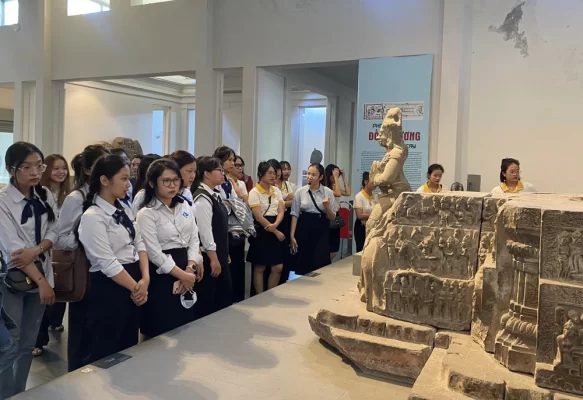
Cham museum often has educational programs
- Hands-On Exhibits: Visitors can engage with various interactive displays that provide a deeper understanding of Cham culture and history. These exhibits often include touch screens, replicas of artifacts, and interactive maps.
- Workshops and Demonstrations: The museum offers regular workshops where visitors can learn traditional Cham crafts such as pottery, weaving, and sculpture. These hands-on sessions are led by local artisans and provide a unique opportunity to create your own souvenirs.
- Educational Programs: For those interested in a more in-depth exploration, the museum organizes educational programs that delve into the archaeological methods used to uncover Cham artifacts, the conservation techniques employed, and the historical context of the items on display.
Click here: Central Vietnam Wonders Tour
2. Guided Tours and Programs
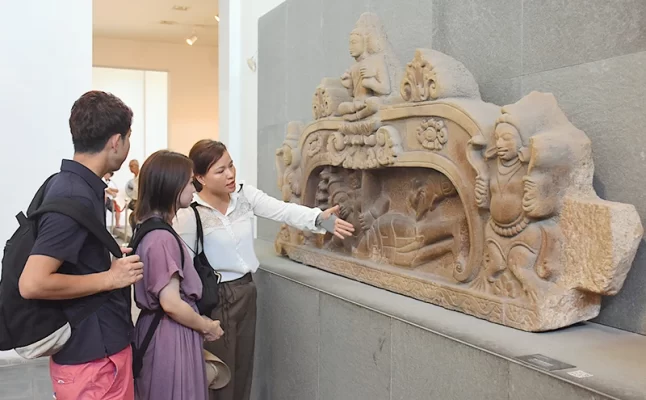
Visitors can hire a tour guide to visit the Cham museum
Automated Free Audio Guide for the Da Nang Museum of Cham Sculpture:
- Step 1: Connect to the museum’s Wi-Fi
- Step 2: Open your web browser and visit https://chamaudio.com.
- Step 3: Choose one of the three available languages: Vietnamese, English, or French, and select the artifact name you want to learn about. Visitors can also play the audio and follow the tour sequence introduced in the app, or scan the barcode next to the artifact for quicker information access.
Hiring a Tour Guide:
- Applicable to: groups of 5 or more people, with commentary available in Vietnamese, English, and French
- Available Hours: Daily from 7:30 a.m. to 11:00 a.m. and from 2:00 p.m. to 5:00 p.m.
- Note: The registration desk stops accepting group requests at 10:00 AM for the morning session and at 4:00 PM for the afternoon session to ensure the minimum time required for the guided tour.
- Booking Requirements: Groups requesting English or French guides need to book with the museum at least 3 days in advance.
3. Unique Experiences Not to Be Missed
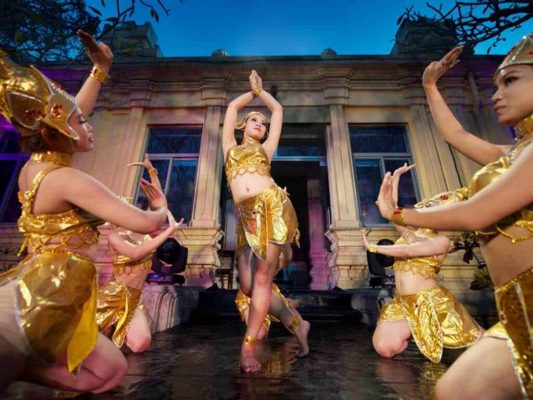
Cultural performance at Cham museum
- Virtual Reality Experience: One of the highlights of visiting the Cham Museum is the virtual reality (VR) experience. This state-of-the-art attraction allows visitors to step back in time and explore ancient Cham temples and cities in immersive 3D environments. It’s a must-try for tech enthusiasts and history buffs alike.
- Cultural Performances: On select days, the museum hosts traditional Cham music and dance performances. These live shows provide a vibrant and engaging way to experience Cham culture and are especially popular with families and children.
- Temporary Exhibitions: The museum frequently hosts temporary exhibitions featuring rare artifacts, contemporary Cham art, or themed displays that provide new perspectives on Cham history and culture. These exhibitions ensure that there is always something new to see and learn at the museum.
V. Practical Information for Visiting the Cham Museum
1. Opening Hours and Ticket Prices
- Opening Hours: The Cham Museum is open daily from 7:00 a.m. to 5:30 p.m., ensuring ample time for visitors to explore its extensive collections.
- Ticket Prices:
- Adults: 60,000 VND (approximately $2.50 USD)
- Students (with valid ID): 30,000 VND (approximately $1.25 USD)
- Children under 6: Free
2. How to Get to the Cham Museum
From Da Nang International Airport:
- By Taxi: A taxi ride from the airport to the museum takes about 10 minutes and costs around 100,000 VND (approximately $4.50 USD).
- By Bus: Bus routes 1 and 2 both stop near the museum. The bus journey takes about 20 minutes and costs 5,000 VND (approximately $0.20 USD).
From Da Nang Train Station:
- By Taxi: A taxi ride from the train station to the museum takes about 15 minutes and costs around 120,000 VND (approximately $5 USD).
- By Bus: Bus routes 4 and 6 are available, taking about 25 minutes and costing 5,000 VND (approximately $0.20 USD).
- Walking/Cycling: For those staying in central Da Nang, the museum is within walking or cycling distance. Walking from the Dragon Bridge takes about 10 minutes.
VI. Travel Tips for Visitors
1. Best Time to Visit the Cham Museum
- Ideal Seasons: The best time to visit the Cham Museum is during the dry season, from February to May. The weather is pleasant, making it easier to explore the museum and other outdoor attractions in Da Nang.
- Avoid Peak Hours: To enjoy a more relaxed visit, it’s advisable to go early in the morning or later in the afternoon. This will help you avoid the larger crowds that often gather around midday.
2. Important Notes When Visiting the Museum
To have a complete visit to the Cham Museum of Sculpture in Da Nang, please note the following:
- Dress neatly and appropriately.
- Do not bring weapons, explosives, flammable substances, pollutants, hazardous materials, or other dangerous items into the museum.
- You may bring money and valuable items into the museum.
- Do not bring large luggage into the museum. Luggage over 3 kg must be checked at the counter.
- Maintain cleanliness and dispose of trash in designated areas. Eating, drinking, and using drugs are not allowed in the museum.
- Do not engage in street vending within the museum.
- Do not bring pets, banners, or signs into the museum.
- Always maintain order and avoid making noise.
- Do not climb on or damage the plants on the museum grounds.
- Without permission from the management, do not organize cultural or recreational activities on the museum grounds.
- Do not touch artifacts, climb on, or sit on display platforms.
- Photography and taking selfies are not allowed in the museum.
- Visitors will be held responsible for any damage caused to the museum.
3. Suggested Nearby Attractions
- Dragon Bridge: Located just a short drive from the Cham Museum, this iconic bridge is famous for its dragon design that breathes fire and water on weekends at 9 p.m. It’s a must-see, especially in the evening.
- Han Market: A bustling market perfect for souvenir shopping, Han Market offers a variety of local goods, from handicrafts to fresh produce. It’s an excellent place to experience the local culture and pick up unique gifts.
- My Khe Beach: One of Da Nang’s most beautiful beaches, My Khe Beach is known for its white sands and clear waters. It’s a great spot to relax and enjoy some leisure time after exploring the museum.
- Marble Mountains: A cluster of five marble and limestone hills, each representing a natural element. Visitors can explore caves, tunnels, and temples, offering panoramic views of the surrounding area.
- Son Tra Peninsula: Also known as Monkey Mountain, this area is home to the Linh Ung Pagoda and the giant Lady Buddha statue. It’s perfect for nature lovers and offers breathtaking views of the coastline.
In conclusion, the Cham Museum stands as a testament to the vibrant history and artistic achievements of the Cham civilization. This museum offers a captivating journey through time, where visitors can explore intricately crafted sculptures, exquisite ceramics, and intricate jewelry that reflect the Cham people’s deep-rooted cultural identity. Each artifact unveils a story of resilience and creativity, providing invaluable insights into Southeast Asia’s rich heritage.
Whether you’re a history enthusiast or simply curious about diverse cultures, a visit to the Cham Museum promises an enriching experience. Don’t miss the opportunity to immerse yourself in this cultural treasure trove and gain a deeper appreciation for the legacy of the Cham civilization. Plan your visit with Ula Travel and uncover the wonders that await at Cham Museum.
Read more: Da Nang travel tips





